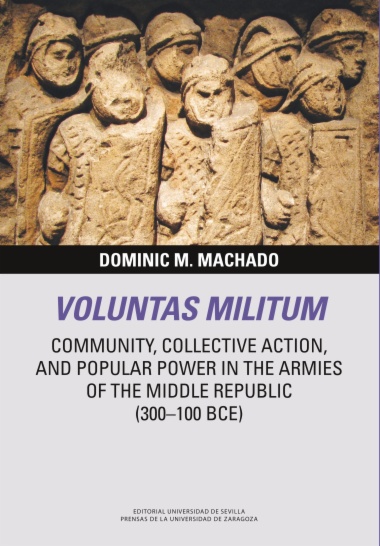Scholars, military men, and casual observers alike have devoted significant energy to understanding how the armies of the Roman Middle Republic (300 – 100 BCE) were able to function so effectively, examining their organization, hierarchy, recruitment, tactics, and ideology in close detail. But what about the concerns, interests, and goals of the soldiers who powered it? The present study argues that the military forces of the Middle Republic were not simply cogs in the Roman military machine, but rather dynamic and diverse social units that played a key role in shaping an ever-changing Mediterranean world. Indeed, the soldiers in the armies of this period not only developed connections with one another, but also formed bonds with non-military personnel who traveled with as well as inhabitants of the places where they campaigned. The connections soldiers developed while on campaign gave them significant power and agency as a group. Throughout the third and second centuries BCE, soldiers took collective actions, ranging from mutiny to defection to looting, to ensure that their economic, social, and political interests were advanced and protected. Recognizing the communities that Roman soldiers formed and the power that they exerted not only reframes our understanding of the Middle Republic and its armies, but fundamentally alters how we conceptualize the turbulent years of the Late Republic and the massive social, political, and military changes that followed.
- CONTENTS
- ACKNOWLEDGMENTS
- Chapter 0: INTRODUCTION
- 0.0: The Roman Army at Rhegium
- 0.1: A Social Historical Approach to the Armiesof the Republic
- 0.2: Periodizing Roman Armies
- 0.3: Roman Military Forces in the Thirdand Second Centuries
- 0.4: Methodology, Sources, and Outline
- Chapter 1: MIDDLE REPUBLICAN ARMIESAS COMMUNITIES
- 1.0: Introduction
- 1.1: Middle Republican Armies as Natural Communities
- 1.2: Middle Republican Armies as Ideological Communities
- 1.3: Communal Ideologies and the Republican Castra
- 1.4: Middle Republican Armies as Families
- 1.5: Conclusion
- Chapter 2: UNIT IDENTITY
- 2.0: Introduction
- 2.1: The Legionary Maniple as Community
- 2.2: Community and Identity among the Italian Allies
- 2.3: Auxiliary Service and Identity
- 2.4: Conclusion
- Chapter 3: CONNECTIONS BEYOND THE CASTRA
- 3.0: Introduction
- 3.1: Movement, Mobility, and the Armiesof the Middle Republic
- 3.2: Slaves, Traders, and Merchants
- 3.3: Prostitutes, Wives, and Businesswomen
- 3.4: Seers, Soothsayers, and Priests
- 3.5: Conclusion
- Chapter 4: FROM COMMUNITY TO COLLECTIVE ACTION
- 4.0: Introduction
- 4.1: From Community to Collective Action
- 4.2: Empowering Collective Action
- 4.3: Imperium sine Imperatore
- 4.4: Potential Deterrents to Collective Action
- 4.5: The Frequency of Collective Actionin the Middle Republic
- 4.6: Roman Armies and Popular Power
- Chapter 5: MATERIAL BENEFITS AND ECONOMIC AGENCY
- 5.0: Introduction
- 5.1: The Economic Benefits of Warfare
- 5.2: Booty and Collective Action
- 5.3: The Stipendium, Rations, and the Second Punic War
- 5.4: Non-Military Personnel and the Economic Benefitsof Military Association
- 5.5: Conclusion
- Chapter 6: STATUS AND SOLDIERING
- 6.0: Introduction
- 6.1: Slavery, Military Service, and Status
- 6.2: Non-Roman Soldiers and the Pursuit of Honor
- 6.3: The Citizen-Soldier and the Reclamation of Honor
- 6.4: Conclusion
- Chapter 7: POLITICS: LOCAL AND GLOBAL
- 7.0: Introduction
- 7.1: Samnite Politics in the First Punic War
- 7.2: Recruiting Resistance
- 7.3: Playing Both Sides
- 7.4: Roman Absence; Non-Roman Agency
- 7.5: Making Connections; Shaping Politics
- 7.6: Conclusion
- Chapter 8: DOMESTIC POLITICS
- 8.0: Introduction
- 8.1: The Political Powers of Middle Republican Armies
- 8.2: Providing Political Legitimacy
- 8.3: Soldiers and the Politics of Roman Military Policy
- 8.4: Conclusion
- Chapter 9: CONCLUSION
- 9.0: Summary of Findings
- 9.1: Broader Implications
- 9.2: Possibilities for Future Research
- BIBLIOGRAPHY
- LIST OF FIGURES
- INDEX OF NAMES AND SUBJECTS
- Contraportada

